SAS Dominates Analytics Job Market; R up 42%
Want to share your content on R-bloggers? click here if you have a blog, or here if you don't.
I’m continuing to gather and analyze data to update The Popularity of Data Analysis Software. In this installment I cover the latest employment figures.
Employment is important to us all, so what software skills are employers seeking? A thorough answer to this question would require a time consuming content analysis of job descriptions. However, we can get a rough idea by searching on job advertising sites. Indeed.com is the most popular job search site in the world. As their CEO and co-founder Paul Forster stated, it includes “all the jobs from over 1,000 unique sources, comprising the major job boards – Monster, Careerbuilder, Hotjobs, Craigslist – as well as hundreds of newspapers, associations, and company websites.” I used a program that went there weekly and searched jobs descriptions for keywords such as “SPSS” or “Minitab.” This was repeated during the 2nd, 3rd and 4th weeks of March in 2012 and 2013. (The data were meant to be for the complete two years, but the automated process went awry.)
The abbreviation “SAS” is common in computer storage, so I avoided those by searching for “SAS !SATA !storage !firmware” (the exclamation point represents a logical “not”). I focused on R while avoiding related topics like “R&D” by using “R SAS” or “SAS R”, including each package in the graph. The data for 2013 are presented in Figure 11.
SAS has a very substantial lead in job openings, with SPSS coming in second with just over a quarter of the jobs. R comes in third place with slightly more than half the jobs available for SPSS. Compared to R or Minitab, SAS has over seven times as many jobs available!
Since 2012, job descriptions that included SAS declined by 961 (7.3%) and those containing Minitab declined by 154 (8.7%). Jobs for R increased by 497 (42%) pushing it past Minitab into third place by a slim margin. In fact, all packages except for SPSS and Systat showed significant though much smaller absolute changes (via Holm-corrected paired t-tests (Table 2). Since these comparisons are based on only three data points in each year, I would not put much stock in most of them, but the 48% increase for R is notable.
Given the extreme dominance of SAS, a data analyst would do well to know it unless he or she was seeking a job in a field in which one of the other packages is dominant.
2012 2013 Difference Ratio 1 SAS 13234 12272 -961 0.93 2 SPSS 3299 3289 -10 1.00 3 R 1196 1693 497 1.42 4 Minitab 1769 1615 -154 0.91 5 Stata 842 898 56 1.07 6 JMP 644 619 -25 0.96 7 Statistica 61 71 10 1.17 8 Systat 14 15 1 1.07 9 BMDP 6 10 3 1.53
Table 2. Number of jobs on Indeed.com that list each software in March of 2012 and 2013. Changes are significant for all software except SPSS and Systat.
R-bloggers.com offers daily e-mail updates about R news and tutorials about learning R and many other topics. Click here if you're looking to post or find an R/data-science job.
Want to share your content on R-bloggers? click here if you have a blog, or here if you don't.

